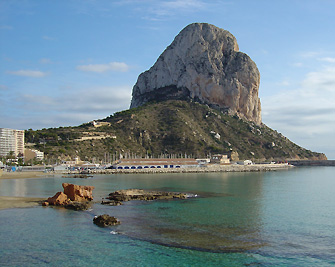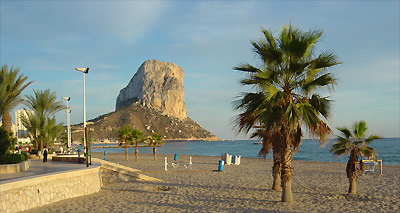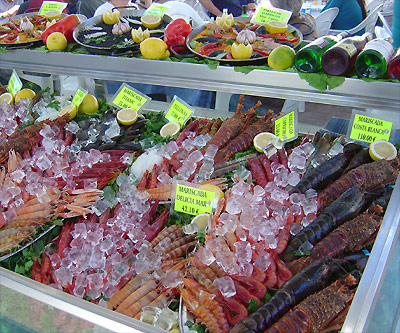
Piñon de Ifach and Port
Between Valencia to the north, and Alicante to the south, the town of Calpe is dominated by the almost 800 foot tall ‘Piñon de Ifach,’ or the rock of Ifach. The rock itself juts out into the sea as imposingly as does Gibraltar, and is a beautiful protected mountain wilderness area.
The huge rock is formed from Eocene and Mycene period calcareous material, joined to the mainland by a detritic isthmus, according to the park’s material handouts. Here can be found over 400 species of native plants, 80 types of nesting birds, and numerous lizard and insect populations of note. At the base are several nice picnic spots for those not wanting to climb the 332 meter rock itself. About two-thirds of the way up, there is a hand-carved tunnel which leads to the eastern side, and more interesting part of the rock itself. Up on top there are several branching trails. One leads to the summit, with breathtaking views, and another to a former civil guard post.
Stretching a mile on either side of Ifach are beautiful beaches with excellent beige sand that are perfect for swimming or just sunbathing. There are three blue flag beaches in Calpe. They are so designated for quality of beach and facilities. For young ones, there’s a children’s areas on either beach. Restaurants, bars and ice-cream shops stretch along a wide promenade to keep you well supplied with refreshments.

Calpe has a lot to offer year-round, from windsurfing and diving to mountain climbing and many other beach sports. At night there are plenty of restaurants, and bars to feed and entertain you, and the stretch of high-rise condos and hotels along the beach cater to many European and international travelers. As you wander about, you’ll hear English, German, Dutch and French along with Spanish on the breeze .
The hillsides around the area are filled with villas as well, for longer-term sun worshippers. This corner of Spain is said to be the sunniest and warmest corner in all of continental Europe.
Ancient mariners settled this coastline two thousand years ago. The Romans were here, and left ruins to prove it. The Romans operated a place here whose main activity was commerce in dried, salted fish. You can see the remains of a large fish factory called the Queen’s Bath (Banys de la Reina) on the south coast near the Moli Tower. This is a fine place to walk up or down the promenade for “la paseo” (an afternoon or evening stroll).
Located along the southern facing coastline, the old town of Calpe is uphill quite a bit from the beach. Which is also where the Market is on Saturday. Here you can find the best bargains on things like clothing, music, furniture, knick knacks, or antiques of dubious quality, but at great prices.
In the ancient town center you will find the Moorish quarter (Arrabal). A walk through here is well worth it, just to imagine the Moors and the Christians living here in peace for many centuries. You will probably also find the town walls, and a church known as the Iglesia Vieja, which I am told is the sole surviving example of Mudejar-Gothic architecture in the land of Valencia. The narrow and twisting streets can be a test of your patience while driving, as locals often stop and unload their cars, double or triple parking in the street to accomplish whatever they are doing, and expect everyone to wait until they are done. It’s best to park and walk through this area, and get your blood pumping and appetite ready for that ‘meñu del dia’ waiting for you.

We recommend a trip to Calpe’s Port to sample from the huge range of fish and shellfish on display! There are several large restaurants displaying the day’s catch on huge platters, ready to order.

